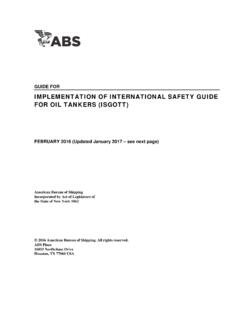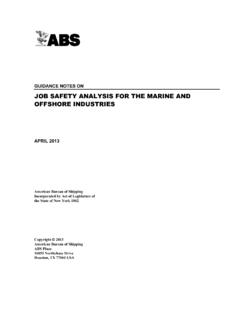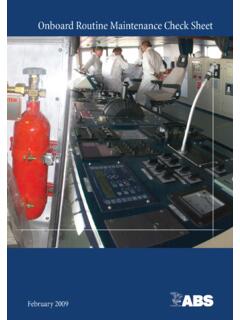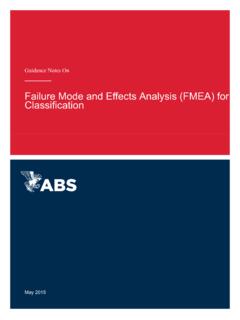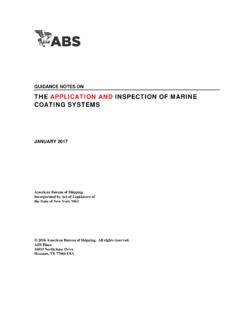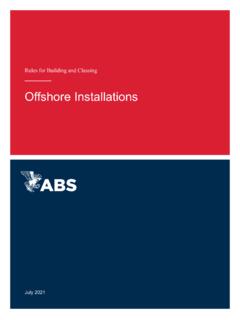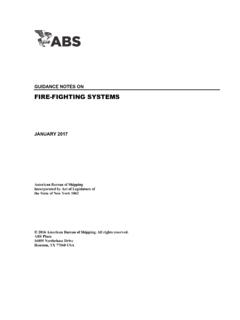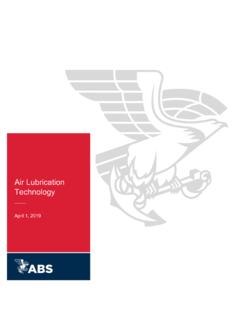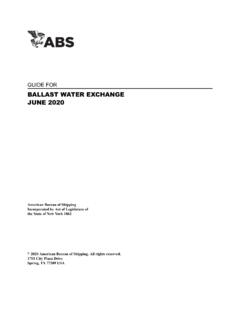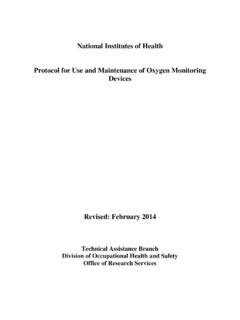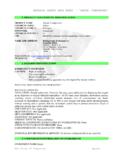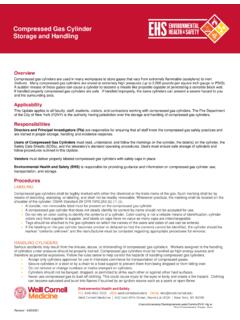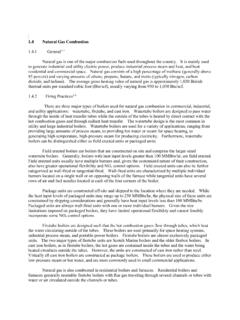Transcription of Guide for Hydrocarbon Blanket Gas System 2014
1 Guide forHydrocarbon Blanket Gas SystemJuly 2014 Guide FORHYDROCARBON Blanket GAS SYSTEMJULY 2014 American Bureau of ShippingIncorporated by Act of Legislature ofthe State of New York 1862 2014 American Bureau of Shipping. All rights Plaza1701 City Plaza DriveSpring, TX 77389 USAF orewordABS has been requested by the industry and regulatory bodies to provide guidelines to address thearrangements where Hydrocarbon produced gas is used as a blanketing gas to maintain a non-explosiveatmosphere inside the cargo storage tanks of ABS Classed floating production Guide has been written for worldwide application and as such, compliance with individualrequirements may require comprehensive data, analyses and plans to be submitted to demonstrate theadequacy of the System . ABS acknowledges that there is a wide range of documents that may be requiredfor submittal to satisfy this type of blanketing System . It is not the intention of this Guide to imposerequirements or practices in addition to those that have previously proven satisfactory in similar currently has requirements for tank blanketing systems using produced gas in 3-5 of the ABSR ules for Building and Classing Facilities on Offshore Installations.
2 Design and installation requirementspresented in this Guide are based on existing industry practice and criteria employed by ABS in the reviewof such systems that are deemed to provide an adequate level of safety equivalent to traditional Inert GasSystems . The application of this Guide by ABS will not seek to inhibit the use of any technologicalapproach that can be shown to produce an acceptable level of the use of hydro carbon blanketing systems, oxygen is eliminated from cargo tanks via the use ofproduced gas, forming an atmosphere within the tank, saturated with Hydrocarbon to a level above theUEL, at which combustion cannot be supported (too rich to burn).Advantages to a HC blanketing System are (1) using a medium which is readily available in large volumeswhich can continuously protect a multitude of large tanks, (2) evaporation in the cargo tank is minimal andthe displaced gas from the tanks can be easily recovered resulting in a safe closed System which enablesubstantial reduction in volatile organic compound (VOC) emissions to the atmosphere.
3 However, one ofthe disadvantages of using a HC blanketing System is that an Inert Gas (IG) Blanket System must be kept asbackup to the HC blanketing System , should the supply of the HC blanketing medium become unavailableCurrently more than 20 offshore production platforms world-wide are using Hydrocarbon gas for tankblanketing and ABS expects more to come as this System is becoming a standard in the Guide is to be used in conjunction with other ABS Rules and Guides, as specified Guide becomes effective on the first day of the month of are advised to check periodically on the ABS website to verify that this version ofthis Guide is the most welcome your feedback. Comments or suggestions can be sent electronically by email Guide FOR Hydrocarbon Blanket GAS System and and Data to be Required for , References, Acronyms and Referenced 85 Acronyms and of Risk Based Techniques to Justify Evaluation of 1111 Other 12 SECTION4 System Gas for Tank Gas Blanketing-Venting Capacity and FORHYDROCARBON Blanket GAS SYSTEMABS Guide FOR Hydrocarbon Blanket GAS System Capacity and Blanket Gas Specification Control Valves (PCVs).
4 Valves (SDVs).. Key Operated Installations in Hazardous and Control 15 SECTION5 Special Considerations for Single Tanks Fitted in the Hull andContaining Low Flash Point Flammable Liquids [Flash Pointof 60 C (140 F) or less].. Arrangement 175 Tank Blanketing System 17 SECTION6 Fire Suppression and Gas 19 ABS Guide FOR Hydrocarbon Blanket GAS System 2014ivSECTION 1 General1 Scope and ApplicabilityThis Guide applies to floating production installations equipped for storage of liquid hydrocarbons, wherehydrocarbon gas is used for tank blanketing as permitted in 3-5 of the ABS Rules for Building andClassing Facilities on Offshore Installations (Facilities Rules).Blanketing systems employed in crude storage tanks and slop tanks are to comply with the requirements inSection 4 of this systems employed in a single tank containing low flash point flammable liquid [flash point of60 C (140 F) or less], such as methanol tanks built as a hull or integral tanks are to comply with thespecial considerations in Section 5 of this and Data to be Required for Reviewi)Document showing standard construction details for piping )Arrangement showing the location of the liquid Hydrocarbon storage hull )Process and instrumentation diagrams of the Hydrocarbon gas Blanket System clearly indicatingconnection to:a)Cargo tanks System ,b)Inert Gas System ,c)Venting System ; and,d)Cargo tank vents recovery System , as applicableiv)Cargo tank venting System , purging and gas freeing systems, including details and setting of thepressure/vacuum valves (relief valves).
5 V)Cause and Effect matrix and Safety Analysis Function Evaluation ( ) charts for the )Since the Hydrocarbon Blanket gas System is a part of the topside process System , the same is tocomply with safety System requirements in 3-3 , Safety System and Chapter 3, Section 7, Instrumentation and Control Systems of the Facilities Rules and API 14C, regardless of theClass Notation of the unit. Applicable process P&IDs and charts are to be submitted forABS )Operating manualABS Guide FOR Hydrocarbon Blanket GAS System Documentationi)Hydraulic calculations for Hydrocarbon Blanket gas capacity, as required in 4 )Results of analysis for tank blanketing, inerting, purging and gas-freeing effectivenessiii)HAZID and HAZOP studies relative to the Hydrocarbon Blanket gas systemiv)Electrical equipment data in hazardous areasv)Gas dispersion analysis, as required in 4 )5 Governmental AuthorityAttention is drawn to the appropriate governmental authority in each case, as there may be Guide FOR Hydrocarbon Blanket GAS System 20146 SECTION 2 Definitions, References, Acronyms and Abbreviations1 DefinitionsThe following definitions, references, abbreviations and acronyms are provided to clarify the use of termsin the context of this Guide .
6 Some definitions were extracted from Gas/Pad Gas. Gas added to the vapor space of a vessel or tank to prevent an explosive or ignitablevapor-air mixture from Shutdown (ESD) System . System of manual stations that, when activated, will initiate Installation. An offshore facility designed to provide Hydrocarbon processing and/or hydrocarbonstorage, and offload hydrocarbons. The term Floating Installation is used to generically identify a buoyantfacility that is site-specific. This installation is securely and substantially moored so that it cannot bemoved without a special effort. The term includes, but not limited to Tension Leg Platforms (TLP), SparBuoy, Permanently Moored Shipshape Hulls and Blow-by. The discharge of gas from a process component through a liquid Sweetening. Process for removal of H2S from sour Areas (Classified Areas). A location in which flammable gases or vapors are or may be presentin the air in quantities sufficient to produce explosive or ignitable mixtures (see the ABS MOU Rules, APIRP 500 or API RP 505 for additional details).
7 Hydrogen Sulfide (H2S). A highly toxic, flammable, corrosive gas sometimes encountered in Hydrocarbon -bearing Sulfide (Sour) Service. Refers to equipment designed to resist corrosion and hydrogenembrittlement caused by exposure to hydrogen Mixture. A mixture that is within the flammable range (between the upper and lower limits) andis therefore capable of propagation of flame away from the source of Gas. A gaseous mixture, such as flue gas, containing insufficient oxygen to support the combustionof Explosive Limit ( ). The lowest concentration of combustible vapors or gases, by volume inmixture with air, which can be ignited at ambient Guide FOR Hydrocarbon Blanket GAS System 20147 Operating Conditions. A set of conditions ( , flowrates, compositions, temperatures and pressures)chosen for normal operation of a production facility at a particular point in the life of an oil or gas Shutdown. The isolation of a given process station from the process by closing appropriate SDVsto shut in flow to the process station or divert flow to another process Station.
8 One or more process components performing a specific process function, such asseparation, heating, pumping, Fluids. Fluids coming out of completed wells, which may consist of oil, water, gas, andcondensable Facilities. For the purpose of this Guide , Production Facilities are typically the processing,safety and control systems, utility and auxiliary equipment, for producing Hydrocarbon liquid and gasmixtures from completed wells or other facilities are generally inclusive from the inlet flange of the well fluid flowline above the water levelto the point at which the departing pipeline enters the water. The facilities also include the safe disposaland/or collection of produced oil, gases and a floating installation with the storage and offloading capability to shuttle tanker, the productionfacility is terminated at the inlet flange discharge into the storage tank. The storage tank and offloadingpiping/electrical systems arrangement are considered marine A System action that will be initiated upon signal or failure and is to result in shutdown ofsystems, subsystems, equipment, component, or part of the Valve (SDV).
9 An automatically-operated, normally closed valve used for isolating a Gas. Gas containing significant amounts of hydrogen sulfide (H2S).Sour Service. Exposure to environments that contain H2S and can cause cracking of materials by themechanisms addressed in NACE MR0175/ISO Event. An adverse occurrence or situation in a process component or process station thatposes a threat to safety, such as overpressure, under pressure, liquid overflow, Condition. A condition that occurs in a process component or System when an operating variabledeviates substantially from its normal operating limits. If left unchecked, this condition can result in athreat to safety and may cause shutting-in of the Referenced Rules FPI Rules ABS Rules for Building and Classing Floating Production Installations Facilities Rules ABS Rules for Building and Classing Facilities on Offshore Installations Marine Vessel Rules ABS Rules for Building and Classing Marine Vessels MOU Rules ABS Rules for Building and Classing Mobile Offshore addition to the ABS Rules in 2 , the additional requirements of the following ABS Guides, ABSG uidance Notes, International/National Codes or Standards and Regulations are referenced in this Guide :Section2 Definitions, References, Acronyms and Abbreviations2 ABS Guide FOR Hydrocarbon Blanket GAS System 20148 International Convention for the Safety of Life at Sea (SOLAS), as amended.
10 ABS Guidance Notes on Review and Approval of Novel Concepts (Novel Concepts Guide ) ABS Guidance Notes on Risk Assessment Applications for the Marine and Offshore Industries API American Petroleum Institute NACE National Association of Corrosion EngineersABS is prepared to consider other recognized codes, standards, alternative design methodology andIndustry practice, on a case-by-case basis, with justifications as indicated in Section 3 of this and AbbreviationsThe following acronyms and abbreviations are used in this Guide :API: American Petroleum InstituteESD: Emergency ShutdownH2S: Hydrogen SulfideHAZOP: Hazard and OperabilityHAZID: Hazard IdentificationIGS: Inert Gas SystemsLEL: Lower Explosive LimitUEL: Upper Explosive LimitNACE: National Association of Corrosion EngineersP&ID: Piping and Instrumentation DiagramPCV: Pressure Control ValvePSH: Pressure Safety HighPSV: Pressure Safety : Safety Analysis Function EvaluationSIS: Safety Instrumented SystemVOC: Volatile Organic CompoundSection2 Definitions, References, Acronyms and Abbreviations2 ABS Guide FOR Hydrocarbon Blanket GAS System 20149 SECTION 3 Recognition of Risk Based Techniques to Justify Alternatives1 GeneralThe requirements detailed herein provide an alternative route to obtain and maintain ABS Class.
